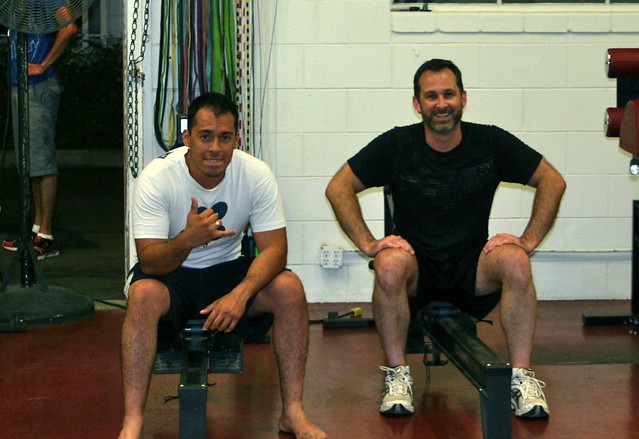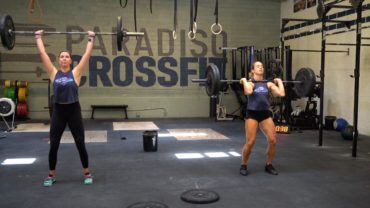Too Much Information, Part 1
Front Squat 5-5-5-5-5
Review the movement standards in the Video Library!
JP and Brandon Pearce basking in the afterglow
As we wait anxiously to crown the winners of our IWC challenge, I thought I would share my past six month journey and quest towards increased work capacity….
It all started with this post from Ronnie Teasdale about his diet. Ronnie runs CrossFit Mean Streets in downtown LA, is a top CrossFit competitor in southern California, and a bit controversial with his viewpoints. Agree with him or not, I was left wondering how he could perform at such a high level while eating little to no carboyhydrates! I had been eating strict Paleo for well over a year, I felt good, my numbers were slowly improving, but this was something completely different. I never really did any research on the topic, but it was stuck in my brain.
About a month later, I watched the DVD lecture series from Mat Lalonde.
(Available to borrow if you are interested in the super sciency bio chemistry information on how food affects the body) In his introductory comments, he discusses some basics about what proteins, carbohydrates and fats are by definition, and makes a comment that stands out, “There are no such things as essential carbohydrates, only essential amino acids.” Hmmm. If I lost you there, what that means is that we can live without veggies, but not without protein. Then he goes on to explain that there is this process called Gluconeogenesis, in which our body can produce its own glucose (sugar) instead of getting it from carbohydrates. He referenced an article he wrote on the topic for Robb Wolf’s blog, so I looked it up. Read the article here, in which he describes his own experiences with what is known as a Ketogenic Diet. After reading the article, I knew I would have to give this a try in the name of science!
From the article: The research on fat adaptation mentioned in one of Robb’s posts told me this wasn’t going to be easy. I figured it would take at least two months to get used to my new diet since enzymes involved in gluconeogenesis and fat burning would have to be upregulated while enzymes for burning sugar would be downregulated. I wasn’t sure this was going to work but I knew the worst thing that would happen was that I wouldn’t set any new PRs for a while. I was pretty sure nothing bad would happen given that the explorers V. Stefansson and K. Andersen survived on a diet of meat and animal fat for one year and came out healthier for it.
That sounded reasonable enough, so I started, just like that. I knew if I was going to be eating that much meat, I wanted it to be quality, grass-fed. I upped my orders from US Wellness so I would have plenty on hand and began the experiment without telling anybody. I coincided my diet change with the decision to sign up for my first individual CrossFit competition at the UTC CrossFit Competition.
The stage was set, the question was, what would happen next…
I didn’t notice much of a change in my energy level over the first two weeks, but I did feel different somehow. Not sick, but just a bit off. One thing I noticed right away was that I didn’t need to eat as often. I was used to eating four or five times a day, but a benefit of consuming so much fat is that it slows down your digestion and keeps you more satiated. About two weeks into the experiment something happened in a WOD…I got abnormally close to Ben Hopkins time. I thought to myself, maybe he was having an off day, overtrained or taking it easy. But the next workout felt the same, there was this strange ability to keep moving through the workout. I was tired, but kept going. There was a strange sense of clarity as I plowed through workouts. I started to think to myself during WODs, “You don’t have to stop, you’re on the Meat!” This led me to believe maybe the whole thing was just a placebo effect, that I was doing better just because I thought I was supposed to be doing better. Hmmm, time for more research…
In that Mat Lalonde article, there is a link to another good read about why our bodies have the ability to even perform this function and why performance improves. If you want to understand how this works on a metabolic level, read the article, but here are a couple excerpts:
Early on, the metabolic system doesn’t know that the starvation is going to go on for a day or for a week or two weeks. At first it plunders the muscle to get its sugar. And remember from a past post that a normal blood sugar represents only about a teaspoon of sugar dissolved in the entire blood volume, so keeping the blood sugar normal for a day or so doesn’t require a whole lot of muscular sacrifice. If we figure that an average person requires about 200 grams of sugar per day to meet all the needs of the glucose-dependent tissues, we’re looking at about maybe a third of a pound of muscle per day, which isn’t all that big a deal over the first day. But we wouldn’t want it to continue. If we could reduce that amount and allow our muscle mass to last as long as possible it would be a help…
The liver requires energy to convert the protein to glucose. The energy comes from fat. As the liver breaks down the fat to release its energy to power gluconeogenesis, the conversion of protein to sugar, it produces ketones as a byproduct. And what a byproduct they are. Ketones are basically water soluble (meaning they dissolve in blood) fats that are a source of energy for many tissues including the muscles, brain and heart. In fact, ketones act as a stand in for sugar in the brain. Although ketones can’t totally replace all the sugar required by the brain, they can replace a pretty good chunk of it. By reducing the body’s need for sugar, less protein is required, allowing the muscle mass (the protein reservoir) to last a lot longer before it is depleted.
And ketones are THE preferred fuel for the heart, making that organ operate at about 28 percent greater efficiency…
Again, if that’s confusing, think about it simply: as hunter gatherers, we very often did not have access to a large amount of carbohydrates (think wintertime, dry seasons, no supermarkets, etc.) This vision makes more sense to me in the Paleo sense of things. When we ate an animal, we at the whole thing, which included a lot of fat! That is the reason we can perform this process and the increased performance comes from those things called Ketone bodies (hence Ketogenic diet) which literally increases the efficiency of the heart. WOW!! It wasn’t in my head at all, this was for real!
Over the first three months leading to the competition, my confidence soared. My met-con couldn’t have been any better, but I still needed to get a lot stronger! The diet did have its limitations, and unfortunately, did not give me actual superpowers or allow me to lift heavy objects with my mind. I had to keep training and getting stronger. I put on about 5 pounds during this time as well (thats a good thing for me). After the competition, I was feeling better than I ever had in my life and I wanted more!
To be continued…
Part 2 of the story tomorrow, including: the dark side of too much protein, what I eat and don’t eat and what’s the point of all this.
















